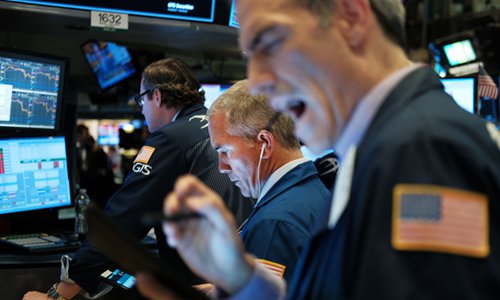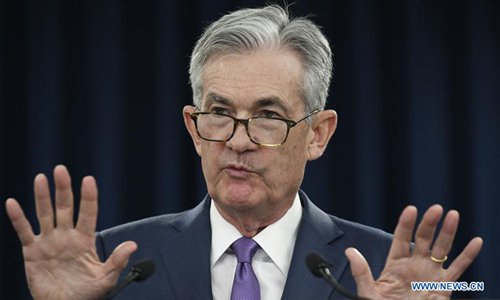HOME >> BUSINESS
Fed cuts give China leeway
By Chu Daye, Song Lin and Xie Jun Source:Global Times Published: 2019/8/1 22:08:40 Last Updated: 2019/8/2 8:29:53
Global slowdown, trade war prompt US decision

Traders react moments before the close of the New York Stock Exchange after the Federal Reserve announced a cut in interest rates on Wednesday. Photo: AFP
The US Federal Reserve's interest rate cuts on Wednesday will give China's policymakers more leeway as China deals with increasing downward pressure in the second half of the year, analysts said on Thursday.
They said while the US rate cuts show the Fed's growing concern over the US economy, China's monetary policy in the second half will be self-paced, unaffected by the US, as the country's economy maintains a stable growth path.
The Fed decision to lower borrowing costs for the first time since 2008 came after China and the US concluded their 12th round of trade talks aimed at resolving the year-long trade war that has slowed both countries' growth, disrupted global supply chains and added uncertainty to global growth.
Following the news, US benchmark indices shed over one percent on Wednesday, while the dollar index reached its highest level since May 2017.
On Thursday, China's stock markets slid, with the Shanghai Stock Composite Index dipping 0.81 percent and the Shenzhen Component Index falling 0.63 percent.
Fed Chairman Jerome Powell cited signs of a global slowdown and the trade war as reasons for the cuts.
However, Powell sent confusing messages, saying "it is not the beginning of a long series of rate cuts," and "I didn't say it's just one rate cut."
US President Donald Trump had hoped that it was the beginning of a lengthy and aggressive rate-cutting cycle to keep pace with China, the EU and other countries, tweeting Powell "let us down."
Zhou Yu, director of the Research Center of International Finance at the Shanghai Academy of Social Sciences, said that the Fed's move is "in line with market expectations."
According to Zhou, the cuts were made amid signs of a slowdown in the US economy. "The negative impact of the China-US trade war on US economy also pushed the Fed to cut interest rates," Zhou said.
The cut was accompanied by monetary easing of central banks in a dozen of countries.
In the past three months, about 12 central banks have announced rate cuts, China News Service reported.
Turkey, Russia and India announced eased policies in anticipation of the Fed rate cut.
In late July, the European Central Bank hinted it could cut interest rates in response to a slowdown in the eurozone economy.
The UAE central bank followed the Fed's rate cut by announcing the same 25 basis point cut on Wednesday.

US Federal Reserve Chairman Jerome Powell speaks during a press conference on Wednesday. US Federal Reserve on Wednesday lowered interest rates for the first time since the 2008 global financial crisis, amid rising concerns over trade tensions, a slowing global economy and muted inflation pressures. Photo: Xinhua
China's move
Zhou said that the Fed's decision opens China's space for further interest rate cuts. "Because Chinese economy is also facing downward pressure, the central bank might cut interest rates in the coming months."
He added if the US economy rebounds after the interest rate cuts, it would also drive up the economy of other countries, and China may also benefit.
However, experts said China's decision would be self-paced, as the country's primary task would be to channel its relatively ample liquidity into the real economy.
"China will not adopt a monetary policy based on what the US does. The Chinese government has been enhancing its new tax and fee reduction policy, which will continue to be prominent this year," said Dong Dengxin, director of the Financial Securities Institute at the Wuhan University of Science and Technology.
China will continue pushing forward many tasks, such as further improving the supply-side structural reform and expanding employment, Dong told the Global Times on Thursday.
Following the US move could disturb China's existing economic strategies, since China has virtually ended its monetary easing policy, Tan Yaling, head of the China Forex Investment Research Institute, told the Global Times.
China also faces less deflation risks, she said.
Meanwhile, China is fully promoting the opening-up of its financial market, with risk prevention its primary concern for now, Tan noted.
Beijing has refrained from using aggressive policy tools, such as lowering lending and deposit rates.
Despite admitting growing downward pressure on economic growth, the Political Bureau of the Communist Party of China (CPC) Central Committee on Tuesday said a proactive fiscal policy should be more efficient and cover larger-scale tax cuts and fee reductions, while monetary policy should remain moderate to maintain liquidity.
China's GDP grew 6.3 percent year-on-year in the first half of 2019, slowing from 6.4 percent in the first quarter but falling within the annual target set by Chinese policymakers, and surpassing those of other global economies.
US GDP grew 2.1 percent from April to June, down from 3.1 percent in the first quarter of the year.
A decade of growth in the US is nearing its end, and a dismal economic forecast may emerge, Dong said.
China's central bank governor Yi Gang said in July that the country's interest rate level is appropriate and any action will depend on China's economic conditions.
Cutting interest rates will mainly deal with the danger of deflation, Yi noted. The central bank has kept the benchmark lending rate unchanged since October 2015.